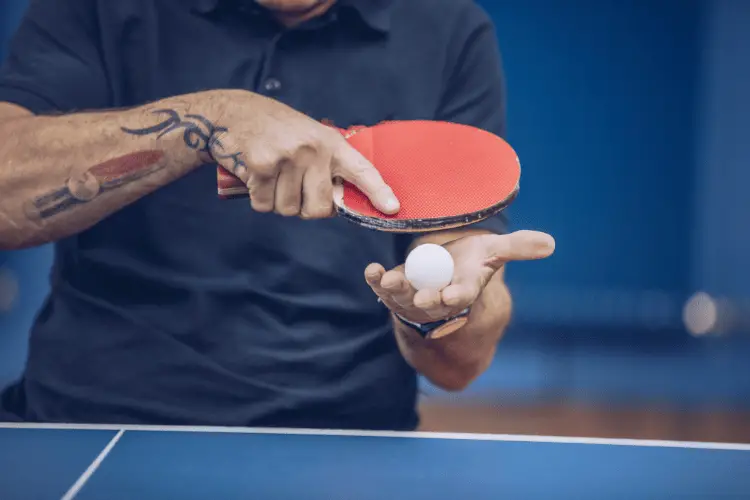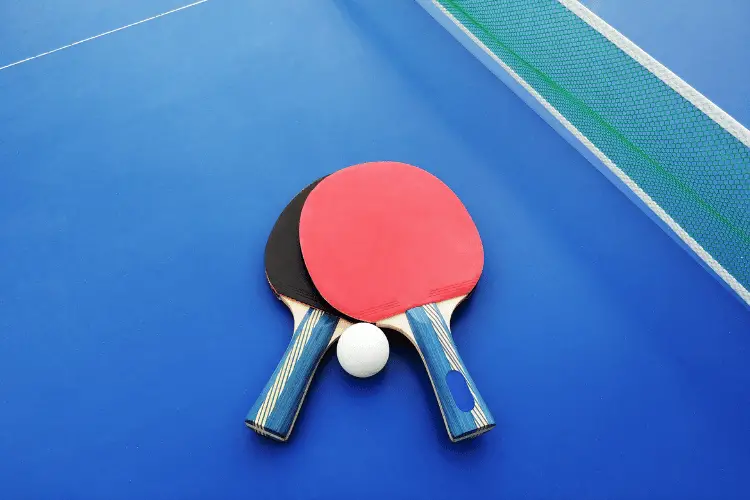Ping pong is not just a game people play when they are bored. There are tons of interesting facts and statistics about ping pong/table tennis that you’ve probably never heard.
For instance, did you know that the longest table tennis rally lasted for 8 hours? Or that table tennis used to go by the name whiff whaff?
Well, if you’re curious about other fun facts and statistics about table tennis, keep reading!
Table Tennis Debut in the Olympics
When the International Table Tennis Federation came to fruition in 1926, they only conducted World Championship matches.
After trying to get the sport included in the Olympic program, it finally debuted in 1988 during the Seoul Games.
Changes in the Rules of Table Tennis
The sport has faced major changes since the early 2000s.
First, table tennis went from a 21-point game to an 11-point game to make the game more exciting. Plus, it’s a way to make the sport appealing to television viewers.
Additionally, the material used to create ping pong balls also changed. The ITTF started utilizing poly or plastic balls instead of celluloid because the latter is highly flammable. It was challenging to store and transport.
How Long Did the World’s Longest Table Tennis Rally Last?
An interesting fact about the world’s first longest table tennis rally is that it happened in 1936, during the World Championships in Prague.
Alex Ehrlich from Poland and Farkas Paneth from Romania started their match with a rally that lasted for almost 2 hours.
According to witnesses, the exact time ranges from 1 hour 58 minutes to 2 hours 15 minutes.
However, the father and son duo from England, Daniel and Peter Ives, broke the record in 2014. They played the longest tennis table rally for a whopping 8 hours and 40 minutes.
According to the duo, they hit the ball more than 32,000 times without interruptions!
Their goal was to play for 10 hours, though it stopped when Peter Ives missed the shot because it hit his finger.
Table Tennis Industry Estimated Growth
According to the latest report by Precision Business Insights, the global table tennis market size has a value of $130 million in 2021.
Experts estimate it’ll grow at a significant compound annual growth rate (CAGR) of 3.5% in the next seven years.
The Various Names of Table Tennis
People marketed the sport under many different names before it became known as table tennis on a global level.
Table tennis also goes by the names:
- Ping Pong
- Whiff Waff
- Pim-Pam
- Pom-Pom
- Gossima
- Indoor Tennis
- Royal Game
- Tennis de Salon
- Netto
- Clip-Clap
Top Table Tennis Players in the World
Many table tennis players raked in thousands of points throughout their careers.
According to the World Table Tennis organization, the following players are the ones who have climbed their way to the top of the leaderboards.
Men’s Singles Division
| Name | Country | Points |
| Fan Zhendong | China | 7,725 |
| Ma Long | China | 4,400 |
| Wang Chuqin | China | 4,345 |
| Harimoto Tomokazu | Japan | 3,860 |
| Calderano Hugo | Brazil | 3,525 |
Women’s Singles Division
| Name | Country | Points |
| Sun Yingsha | China | 8,270 |
| Chen Meng | China | 6,740 |
| Wang Manyu | China | 5,275 |
| Wang Yidi | China | 5,175 |
| Ito Mima | Japan | 2,990 |

Countries With the Most World Table Tennis Championships Medals
The World Table Tennis Championship happens biennially. The individual events occur during odd-numbered years, while the team events happen in even-numbered years.
The People’s Republic of China dominates individual and team events, followed by Hungary and Japan. The countries mentioned below garnered hundreds of medals throughout the years.
| Team | Gold | Silver | Bronze | Total |
| China | 107 | 93 | 159.5 | 359.5 |
| Hungary | 56 | 45 | 64.5 | 165.5 |
| Japan | 33 | 27 | 55 | 115 |
| Czechoslovakia | 19 | 27.5 | 46.5 | 93 |
| Romania | 12 | 5.5 | 13.5 | 31 |
Prevalence of Injuries in Table Tennis
A study discovered that there’s a high injury rate when it comes to table tennis.
The researchers observed the players who participated in Taiwan’s 2019 National Intercollegiate Athletic Games. 50.7% of them experienced an injury. Although some were mild cases, 33.8% of the injured players had to stop training.
The region where the players experienced an injury are as follows:
- Upper limb injury
- Lower limb injury
- Trunk injury
- Head and neck injury
| Region of Injury | Mild (n = 49) | Moderate to Severe (n = 25) |
| Lower limb injury | 29 (59.2%) | 12 (48.0%) |
| Upper limb injury | 30 (61.2%) | 20 (80.0%) |
| Trunk injury | 19 (38.8%) | 9 (36.0%) |
| Head and neck injury | 3 (6.1%) | 2 (8.0%) |

Ping-Pong Diplomacy
Did you know that table tennis served as a peacemaking deal during the Cold War?
During the 1971 World Table Tennis Championship in Nagoya, Gleen Cowan of the U.S. team got left behind by the team’s bus. So, he boarded the Chinese team’s bus instead.
Zhuang Zedong, a Chinese player, approached Cowan and offered him a silk cloth with an image of the Huangshan Mountains.
Journalists managed to capture photos of the two players together. Eventually, the U.S. team received an official invitation to an exhibition game in China.
The First Paddle Used in Table Tennis
In 1880, British army officers played table tennis indoors using cigar box lids as paddles.
Moreover, they used rounded wine bottle corks as their ping pong balls and books as their net.
Evolution of the Table Tennis Racket
Did you know that table tennis went through several racket changes?
1. Hard Bat Era
From the 1920s up to 1950, table tennis players only used hard bats. These are wooden blades with rubbers attached that have pimples on them.
Hard bats suffered a decrease in speed and spin compared to the regular bat that we use today. So, instead of a fast-paced, heavy topspin attacking style, players did slower shots.
Despite the setback, this era managed to produce memorable champions, one of which is Maria Mednyanszky. The Hungarian table tennis player bagged the gold medal five consecutive times during the early years of the World Championships.
2. Sponge Bat Era
In 1952, the Japanese world champion Hiroji Satoh unveiled the wonders of installing 7mm-thick sponges in his racket.
Although it seemed like an unfair advantage at the time, the rest of the world eventually caught up to Satoh’s technological advancement.
As a result, the playing style of table tennis started becoming more fast-paced.
3. Speed Glue Era
The last revolutionary change that happened to table tennis rackets was the use of speed glue. In the 1970s, Tibor Klampar of Hungary discovered the use of said material.
Spreading speed glue (usually bicycle puncture repair glue) on the racket made the porous cells of the rubber expand.
As a result, it gives the racket tension, making the ball behave like it’s bouncing on a trampoline. So, it made powerful shots easier to play.
Wrapping Up
Table tennis is definitely a sport for all seasons because you can play it anytime you want.
Aside from being enjoyable, the sport is also interesting because it underwent significant evolutions throughout the years. It’s no wonder why famous personalities play it.
After all, if it wasn’t enjoyable, it wouldn’t be one of the most played sports in the world today, right?
So, we hope that you had a fun time reading fun facts and statistics about ping pong/table tennis!
References
- http://etthof.org/project/maria-mednyanszky/
- https://www.researchgate.net/publication/349733437_In_the_beginning_was_the_half-volley_The_history_of_defence_in_table_tennis-revised
- https://www.taipeitimes.com/News/sport/archives/2009/04/01/2003439911
- https://worldtabletennis.com/rankings
- https://www.dailymail.co.uk/news/article-2590843/Father-son-break-world-record-longest-table-tennis-rally-lasting-eight-hours-40-minutes.html
- https://precisionbusinessinsights.com/market-reports/table-tennis-market/
- https://issuu.com/rekhamuthyala2/docs/table_tennis_market
- https://www.ittf.com/history/documents/historyoftabletennis/
- https://www.ncbi.nlm.nih.gov/pmc/articles/PMC8678010/
- https://diplomacy.state.gov/ping-pong-diplomacy-historic-1971-u-s-table-tennis-trip-to-china/
- https://www.liveabout.com/history-of-table-tennis-ping-pong-3173595
- https://cdn.megaspin.net/rules/pdf/2022/ittf-rules-all.pdf
- https://www.wsj.com/articles/SB10001424052748704852004575258453401865066


